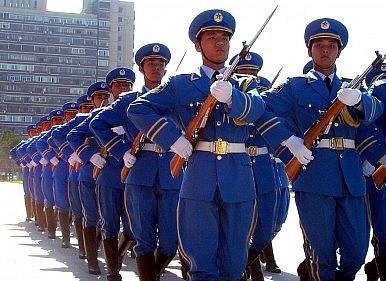Through Japanese Eyes: World War II In Japanese Cinema
By: US Naval Institute Staff
A film about kamikaze pilots has been playing to packed theaters from Hokkaido to Kyushu since its release in December of 2013, becoming one of the top-grossing Japanese productions of all time. In addition to attracting the admiration of Prime Minster Shinzo Abe, "The Eternal Zero" has drawn a fair amount of criticism for being the latest in a string of recent films that mythologize the Japanese role in World War II.
Any Japanese film concerning World War II is going to be closely scrutinized by Japanese and international audiences alike. Most Japanese films produced in the first few decades following the war focus on human tragedy while keeping away from anything that could be construed as glorifying combat or defending Japan's military adventurism. To avoid possible offense, American and Allied Forces in Japanese productions have usually been faceless, instead being represented by their machines of war (as opposed to contemporary Hollywood productions that often include rather negative stereotypes of Japanese soldiers). Americans and the Allied Forces are also rarely even named, usually referred to simply as the enemy.
However, Japanese films generally fail to explain the cause of the war, which has led to a spate of recent movies that cast Japan in a more sympathetic light. With bigger budgets and slicker production values than the stark and repenting post-war movies, these films portray a more romantic view of the fight against the West where Japan is a victim, not the aggressor. As Japanese films become more revisionist, great concern has already been expressed about the current generation of movies such as The Truth about Nanjing which boldly dismisses war atrocities as Chinese propaganda. The film's director has stated that the Japanese leaders executed for war crimes are martyrs like Jesus Christ.
These are a several notable films about World War II produced in Japan:
The Eternal Zero (Eien no Zero) 2013 – Using a flashback narrative, The Eternal Zero follows two siblings as they try to learn more about their grandfather who apparently was determined to survive the war but decided to die as a kamikaze. Some domestic and foreign critics have dismissed the film as shameless nationalistic propaganda. They argue that instead of being patriots who willing sacrificed themselves for Japan, kamikaze were actually vulnerable young men who were radicalized or pressured by fanatics into pursuing an "honorable" death.
The Men of the Yamato (Otoko tachi no Yamato) 2005 – The Men of the Yamato is a big budget production with a story structure and visuals clearly modeled after Hollywood blockbusters. The film depicts the fate of the world's largest battleship and members of the crew as they are sent on a desperate mission to Okinawa where — spoiler alert — the pride of the Japanese Imperial Navy is destroyed by U.S. Navy pilots.
Sea Without Exit (Deguchi no nai umi) 2007 – Kaiten pilots operated one-man submarines that served as human-guided torpedoes, making them the underwater counterparts to the better known kamikaze who attacked from the air. Sea Without Exit chronicles a star baseball player and his three fellow kaiten pilots as the struggle between a sense of patriotic duty and the fear that their lives will be wasted in a war that is already lost.
Fires on the Plain(Nobi) 1959 – After receiving an Academy Award nomination for his 1956 anti-war film The Burmese Harp, director Kon Ichikawa explored even darker themes in Fires on the Plain. The plot concerns a group of Japanese soldiers trapped in the Philippines with little food or supplies because of the tightening noose of the Allied Forces. A brutal film, the graphic depiction of the soldier's efforts to survive through murder and cannibalism was met with critical disdain upon its release.
Zero Fighter(Zerosen moyu) 1984 – Zero Fighter covers the history for the famed plane from its design and early dominance in the air until the end of the war when it is eventually outclassed by advanced enemy aircraft attacking in superior numbers. If the special effects seem strangely reminiscent of Japan's popular superhero and monster movies, Zero Fighter was produced by the same studio and special effects team responsible for several Godzilla films.
For Those We Love (Ore-kimi) 2007 – Written by Governor of Tokyo Shintaro Ishihara, For Those We Love tells the tale of several young kamikaze pilots as remembered by the matron of the local restaurant they frequented while waiting for the final mission. Considering Ishihara's right wing political views, it probably should come as no surprise that the kamikaze pilots are glorified as heroes who died protecting their homeland rather than tragic causalities of Japan's imperialistic ambitions.
Grave of the Fireflies (Hotaru no haka) 1988 – Grave of the Fireflies is a widely acclaimed animated film that follows an orphaned brother and sister as they struggle to survive in a Japan devastated by war. Film critic Roger Ebert ranked it as one of the best war films ever made, stating that its emotional breadth almost moved him to tears. The popularity of the movie in Japan has spawned two live action versions.
Merdeka 17805 2001 – The producers of Merdeka 17805 claim the film commemorates Japan's role in bringing independence to Indonesia by ending Dutch colonial rule, but the release was met with criticism for offering a revisionist view that presents Japanese military aggression as being merely a desire to protect Asia from the West. Scenes depicting Indonesians kissing the feet of their Japanese liberators as well as soldiers slapping the faces of Indonesian recruits were deemed highly offensive to the nation's Muslim population.
Battle of Okinawa (Gekido no showashi:Okinawa kessen) 1971 – As the title states, Battle of Okinawa is a drama about the last major confrontation between Allied and Japanese Imperial forces. While the film faults Japanese leaders for failing to provide their soldiers with sufficient resources to defend the island from the Allied onslaught, the Okinawans caught in the middle of the fighting are portrayed as the true victims.
Japan's Longest Day (Nihon no ichiban nagai hi) 1967 – Even after two of their cities had been devastated by atomic bombs, hardliners within the Imperial Japanese military were still prepared to fight to the death. Japan's Longest Day recounts the true events of August 14-15 when a group of fanatical soldiers attempted a coup to prevent the broadcast of Emperor Hirohito's message of surrender.
Better Wishes for Tomorrow (Ashita e no yuigon) 2007 – Like the 1998 film Pride: A Fateful Moment about Prime Minister Hideki Tojo, Better Wishes for Tomorrow attempts to humanize a Japanese leader on trial for war crimes . Responsible for the execution of American airmen, Tasuka Okada is portrayed as a dedicated family man who acted out of love for country. Both films seem to imply that any atrocities committed by the Japanese during the war were negated by Allied bombing of civilians.













